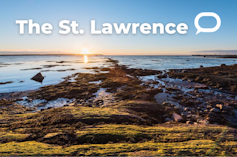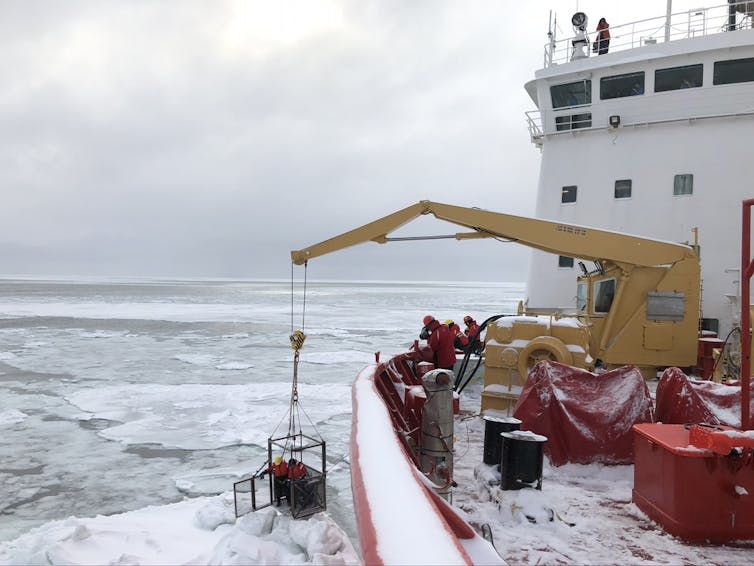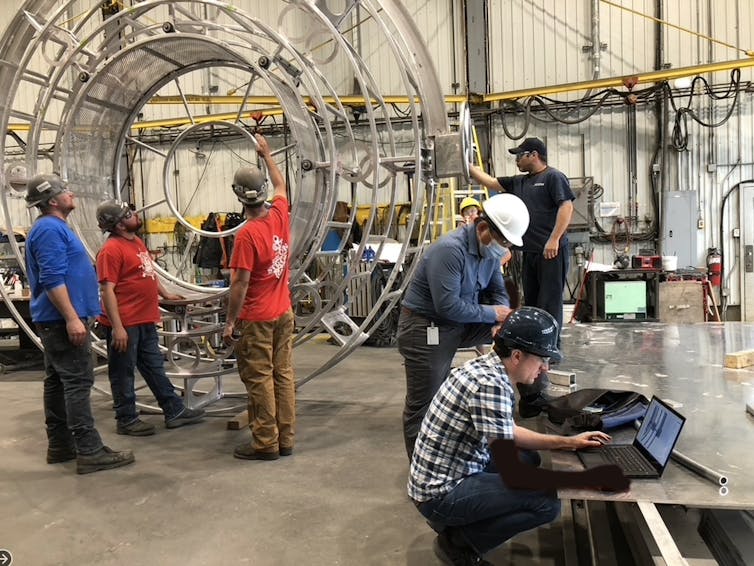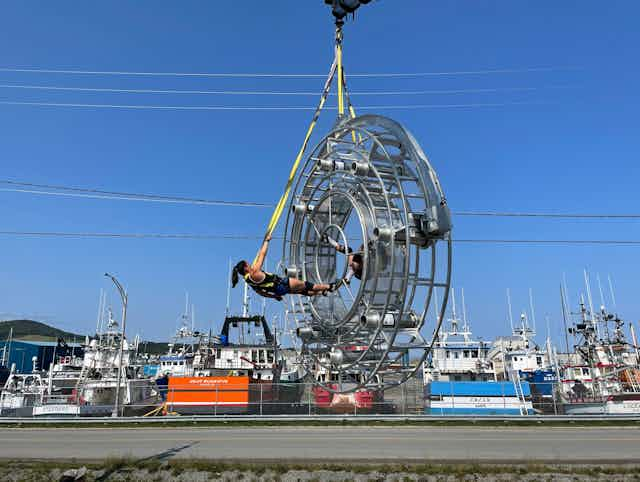The St. Lawrence River constitutes an immense theatre of activity that is beyond our comprehension. The size of the river makes it impossible to grasp it in its entirety. Even if we were to gather together all the scientific, economic, historical, cultural, industrial, political and logistical knowledge we have about the river, it would be impossible to understand its dynamics as a whole.
If we cannot capture the true scope of the St. Lawrence through science, can the performing arts allow us to see the bigger picture? This article recounts the journey of the ecH₂osystème project, where, through the circus arts, I try to express the complexity of what connects us to the St. Lawrence ecosystem through the people who work on its waters.

This article is part of our series, The St. Lawrence River: In depth. Don’t miss new articles on this mythical river of remarkable beauty. Our experts look at its fauna, flora and history, and the issues it faces. This series is brought to you by La Conversation.
ecH₂osystème is a documentary-type maritime research-creation project. The approach is the source of my doctorate in arts studies and practices at UQAM and various scientific and artistic projects that combined 20 years in the performing arts with my long-standing fascination for the maritime world.
Research-creation has a dual objective: the production of a work and of the knowledge gathered while creating it. ecH₂osystème mobilizes knowledge, facilitates intersectorality, meshes the arts and sciences and questions the arts as a mode of knowledge starting from an ecosystem of which we are part. From these reflections, in 2020 I proposed carrying out maritime research-creation in the sense that the waters themselves would drive the creation, unlike a project that starts from a concept, a text, an aesthetic, a performance or a staging.
Change of course
In 2017, I left a career punctuated by different creative projects and travels throughout the world to turn my attention to the St. Lawrence.

Two things drove my decision. In 2016, following the creation of Luzia, by the Cirque du Soleil, I took a few weeks’ break from my theatre work to cross the Panama Canal to Ecuador as a crew member on a ship. One day, during a stopover, the scientific team of Gorgon invited me into the field. I was swimming towards the island when two jets of water shot out. I was taken by surprise by two whales, and, not wearing a life jacket, almost drowned. I have never forgotten this immense lesson.
The second element is linked to the first maritime stage project I worked on. Avudo was a large-scale project by the Compagnia Finzi Pasca that was part of the festivities around the 375th anniversary of Montréal. As director of the artistic and historical content, I spent three years doing research to tie together my synopsis and the colours of the river.
Throughout this process, I was absorbed by a historical perspective of the river. But what about the St. Lawrence today?
Thousands of memories
Between 2017 and 2022, I set out to explore the river at the Gulf of St. Lawrence aboard a variety of fishing vessels, research vessels, bulk carriers, ferries, tugs, barges, and even a tractor operating on a part of the coastline set between the extreme limits of high and low tides known as the intertidal zone.
Five years of research allowed me to work with over 300 partners from marine and freshwater sciences, fisheries, and the maritime and port industries. They included representatives of different research groups, government departments, corporations, First Nations, harbour authorities, institutes, networks, municipalities and family traditions. They covered all generations, from professors to students trained in the latest technology. They contributed to the story line through the transmission of their knowledge and experience, as well as through links forged throughout the project. I gathered literally thousands of memories during my interactions with them.

I recorded these parcels of experience that brought together maritime, scientific and fishing knowledge, in real time. Moving to a soundtrack composed of the voices of my many collaborators, recorded on the spot, acrobatic manoeuvres transport spectators to a port, a laboratory, a ship deck or, for example, to a winter scientific mission of the Québec Maritime Network, aboard the icebreaker CCGS Amundsen, the moment oceanographers discovered a (rare) halibut larva in their sampling net.
The O of ecH₂osystème, a unique device
In order to transport the river to the stage, I came up with the idea of a maritime acrobatic ship. As a researcher at the Center for Research, Innovation and Transfer in Circus Arts (CRITAC), I designed the O d’ecH₂osystème in 2018. The O is a wheel four metres in diameter that can be placed, using a crane, on the deck of a ship, a wharf or the banks of large and small municipalities along the shores of the St. Lawrence. The water in the background becomes the heart of the real-time narrative.
In 2020, the creation of the O brought together an intersectoral research team and partners that included the Réseau Québec Maritime, Doorspec, Multi-Électronique and the Groupe Océan shipyard where this unique device was built. Tests on the O during the summer of 2022 were the start of a new phase of the project, supported by the CALQ, the CCA, the NSERC Innovation Program and others.

This new phase allowed for a series of collaborative work residencies where scientists became co-choreographers, fishermen co-directors and sailors co-playwrights.
From the river to the spectator and from the spectator to the river
ecH₂osystème does not explain the disproportionate scale of the St. Lawrence ecosystem. It seeks to stage it by transferring the knowledge of its many actors. If the O is hoisted to the top of a crane, the acrobat becomes tiny. At 20 meters high, the water column becomes vertiginous. Instinctively, we hold our breath. If the wind picks up, the sensation increases, even if the acrobat is in a harness and all safety measures are being taken by the crew of the O.
Building on contemporary documentary theories and the writings of director Peter Brook, the performing arts have the ability to intersect with reality and go beyond words, data or representation. In 1989, filmmaker Pierre Perrault searched for a present tense in the river, asking, “Does it even exist?” The arts become a lens that allows us to narrow life down by transposing it onto an intelligible scale.

My first weeks of marine acrobatic exploration in Sept-Îles, Pointe-aux-Trembles, Rimouski and Rivière-au-Renard showed promising preliminary results. This exploration will continue in the summer of 2023 in different riverside municipalities so that in the following year I will be able to mesh the different scenes that were co-orchestrated with collaborators. The aim of this first show, designed for the general public, will be to reflect the St. Lawrence on a larger scale.
By seeking to highlight the links between the river and the spectator and between the spectator and the river, ecH₂osystème is interested in the way research-creation invites us to represent our links with an ecosystem “in which we live, not as spectators, but as participants”.
The waters of the St. Lawrence are home to microscopic shrimp that are swallowed up by the largest giants on the planet. These shrimp flow from melting glaciers into the taps millions of us use every day. Over the next few decades, this knowledge will carry ecH₂osystème from the currents of the Great Lakes to the Arctic, back to the stage, to viewers who participate in this ecosystem.


